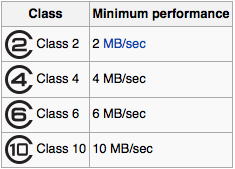There are now fewer types of camera memory card to choose from in terms of form factor (remember those ultra-thin SmartMedia cards from a few years ago?). Those types remaining offer an increasing range of performance features. Secure Digital and Compact Flash cards are currently the dominant memory cards in the digital camera market, along with the SD variants: Mini SD and Micro SD cards (used mostly in phone cameras and other portable devices).
Memory cards come with widely different data capacities, as well as with different recording speeds. As new technology develops so the maximum possible capacity of the card increases. This has given us yet more standards to digest. For example: SDHC, and the newer SDXC capacity cards.
SDSC (standard SD cards) had a maximum capacity of 2Gb.
Secure Digital High Capacity cards come in capacities up to 32Gb.
Secure Digital eXtended Capacity cards can accommodate up to 2Tb - although the highest-rated SDXC card currently sold is 'only' 128Gb. Increased SDXC capacities will be commercially available in the near future.
The other main characteristic of a camera memory card is its read/write speed - essentially how fast it can record the data from a fast-shooting camera plus read and play back data. This is where we can get a bit confused. Most cards record data at a variable rate, depending on the shooting situation (blue sky versus a forest: plain tones record faster than busy tonal images), the type of file (i.e. JPEG or RAW) and the type of connectivity (Firewire, USB 2.0 or 3.0).
Even more important is the (often overlooked) fact that cards don't record and write data at the same speeds. This might not be so significant for recording single still images, but it seriously impacts when shooting high resolution RAW files and video.
Early in the development of camera memory cards, these speeds were always quoted as a multiple of the original CD ROM, 150kB/s burn speed (approx 1.23Mbit/s).
For photographers a better way to describe card performance is a data rate measured in megabytes per second (MB/s). I think we photographers understand megabytes better than 'megabits'. i.e.
16x = 2.24 MB/s
32x = 4.69 MB/s
48x = 7.03 MB/s
100x = 14.6 MB/s
200x = 30 MB/s
1000x = 150 MB/s
Currently there's a slightly simpler 'Class' system used by the SD Association to give consumers a quicker idea if a card is suitable [principally] for shooting big files or for video. The Class System displays the minimum performance of the card in relation to specific applications.
The SD
Association defines standard speed classes indicating minimum performance to
record video. Both read and write speeds must exceed the specified value. These
are defined in terms of suitability for different applications:
Class 2 for SD
video recording
Class 4 and 6 for
HD - Full HD video recording,
Class 10 for Full
HD video recording and HD still consecutive recording
UHS: Even Faster SD Card Standards
The Ultra-High
Speed (UHS) designation is available on some SDHC and SDXC cards.UHS Speed Class 1 is designed for real-time broadcasts and large-size HD videos. UHS-I SD cards can transfer 104 MB/s. UHS-I
is the only class for which products are currently available.
UHS-II cards (when commercially available) will further raise the data transfer rate to a
theoretical maximum of 312 MB/s.
Note also that UHS memory cards
work best with UHS host devices. The combination lets the user record HD
resolution videos to tapeless camcorders while performing other functions. It's also suitable for real-time broadcasts and capturing large HD videos.
UDMA: Even Faster CF Cards
UDMA, or Ultra Direct Memory Access technology greatly increases write speeds
as well as read speeds when the card is inserted into a UDMA-enabled
reader. Currently the fastest CF cards comply with UDMA 7 standards, providing 150 Mb/s write speeds and 20 Mb/s write speeds. As with the UHS standard, this super-fast performance is only possible when using UDMA enabled cameras and card readers.













